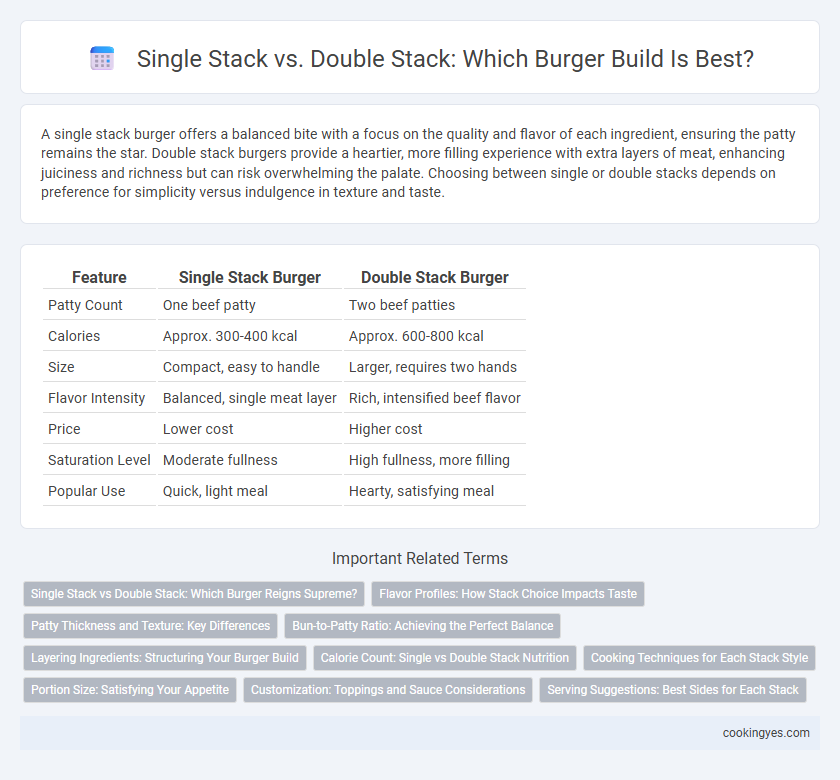A single stack burger offers a balanced bite with a focus on the quality and flavor of each ingredient, ensuring the patty remains the star. Double stack burgers provide a heartier, more filling experience with extra layers of meat, enhancing juiciness and richness but can risk overwhelming the palate. Choosing between single or double stacks depends on preference for simplicity versus indulgence in texture and taste.
Table of Comparison
| Feature | Single Stack Burger | Double Stack Burger |
|---|---|---|
| Patty Count | One beef patty | Two beef patties |
| Calories | Approx. 300-400 kcal | Approx. 600-800 kcal |
| Size | Compact, easy to handle | Larger, requires two hands |
| Flavor Intensity | Balanced, single meat layer | Rich, intensified beef flavor |
| Price | Lower cost | Higher cost |
| Saturation Level | Moderate fullness | High fullness, more filling |
| Popular Use | Quick, light meal | Hearty, satisfying meal |
Single Stack vs Double Stack: Which Burger Reigns Supreme?
Single stack burgers offer a balanced bite with a focus on quality ingredients and flavor harmony, making them ideal for those who prefer a less overwhelming meal. Double stack burgers deliver a more intense, meat-forward experience with added juiciness and texture, appealing to those seeking a hearty, protein-packed option. Choosing between single and double stack depends on individual appetite and flavor preference, but double stack reigns supreme for satisfying larger hunger cravings.
Flavor Profiles: How Stack Choice Impacts Taste
A single stack burger highlights the distinct flavor of each ingredient, allowing the beef patty's juiciness and seasoning to stand out without overwhelming the palate. Double stack burgers intensify taste complexity by layering multiple patties and toppings, creating a richer and more robust flavor experience. Choosing between single or double stack directly impacts the balance and intensity of savory, smoky, and tangy notes in every bite.
Patty Thickness and Texture: Key Differences
Single stack burgers feature a thicker patty, typically around 1/3 to 1/2 inch, delivering a juicy, tender texture with a more pronounced beef flavor. Double stack burgers use two thinner patties, generally about 1/4 inch each, which create a layered texture and allow for a higher ratio of crispy edges to juicy interior. The choice between single and double stack impacts the overall mouthfeel and bite experience, balancing patty thickness with textural contrast.
Bun-to-Patty Ratio: Achieving the Perfect Balance
The bun-to-patty ratio plays a crucial role in burger satisfaction, with single stack burgers offering a more balanced bite where bun softness complements patty juiciness. Double stack burgers increase meat volume but can overwhelm the bun, often leading to a bun-to-patty imbalance that affects overall texture and flavor harmony. Optimizing this ratio ensures every bite maintains structural integrity and flavor equilibrium, enhancing the eating experience.
Layering Ingredients: Structuring Your Burger Build
Single stack burgers showcase a balanced layering of a single patty, fresh lettuce, tomato slices, and melted cheese, maximizing flavor without overwhelming the palate. Double stack burgers double the beef patties and cheese layers, creating a taller, meatier experience that demands sturdy buns and strategic ingredient placement to maintain structural integrity. Proper layering, such as placing sticky condiments between patties and cushioning buns, ensures every bite delivers optimal taste and texture.
Calorie Count: Single vs Double Stack Nutrition
A single stack burger typically contains around 250 to 350 calories, providing a balanced portion size with less fat and sodium. In comparison, a double stack burger doubles the patty and cheese, raising the calorie count to approximately 500 to 700 calories, along with increased saturated fat and cholesterol levels. Choosing a single stack burger supports lower calorie intake, beneficial for weight management and heart health.
Cooking Techniques for Each Stack Style
Single stack burgers cook more evenly due to their thinner patty, allowing for faster heat penetration and a juicier interior when grilled or pan-fried. Double stack burgers require careful temperature control and longer cooking times to ensure the thicker meat reaches safe internal temperatures without burning the exterior. Techniques like pressing or flipping frequently can help achieve consistent doneness and maintain moisture in double stack builds.
Portion Size: Satisfying Your Appetite
Single stack burgers offer a lighter portion size, ideal for those seeking a satisfying yet manageable meal without overwhelming calorie intake. Double stack burgers provide a heartier option, doubling the layers of meat and toppings to fully satisfy larger appetites or intense cravings. Choosing between single and double stack depends on personal hunger levels and nutritional preferences, balancing portion size with taste satisfaction.
Customization: Toppings and Sauce Considerations
Single stack burgers offer a balanced canvas for customization, allowing toppings and sauces to meld seamlessly without overwhelming the bun, which enhances flavor clarity. Double stack burgers provide more surface area for diverse toppings and layers of sauce, enabling bold combinations but requiring careful portioning to prevent sogginess and structural instability. Choosing between single and double stacks depends on preferred texture balance and the complexity of desired sauces and toppings, ensuring maximum customization without compromising the eating experience.
Serving Suggestions: Best Sides for Each Stack
Single stack burgers pair perfectly with lighter sides such as a crisp garden salad or sweet potato fries, balancing the burger's moderate size and flavors without overwhelming the palate. Double stack burgers benefit from heartier sides like classic French fries or onion rings, complementing the burger's substantial, layered ingredients with satisfying crunch and richness. Both stack styles can be enhanced with complementary dips like tangy ketchup or smoky barbecue sauce to elevate the overall meal experience.
Single stack vs Double stack for burger build Infographic

 cookingyes.com
cookingyes.com